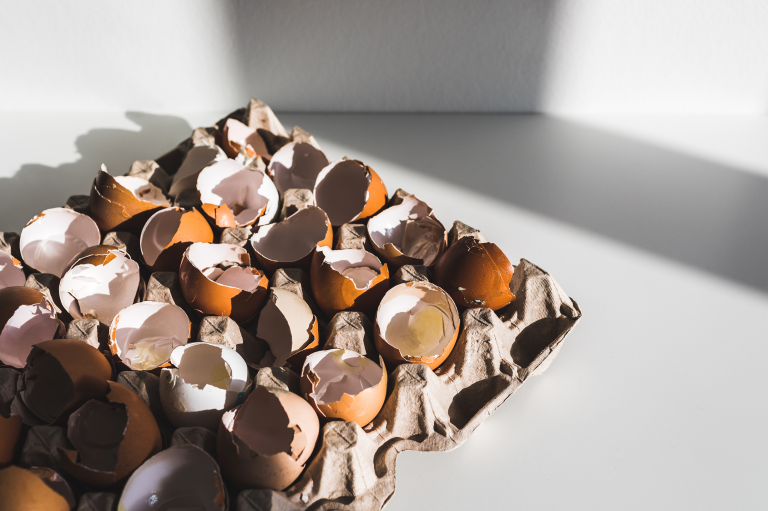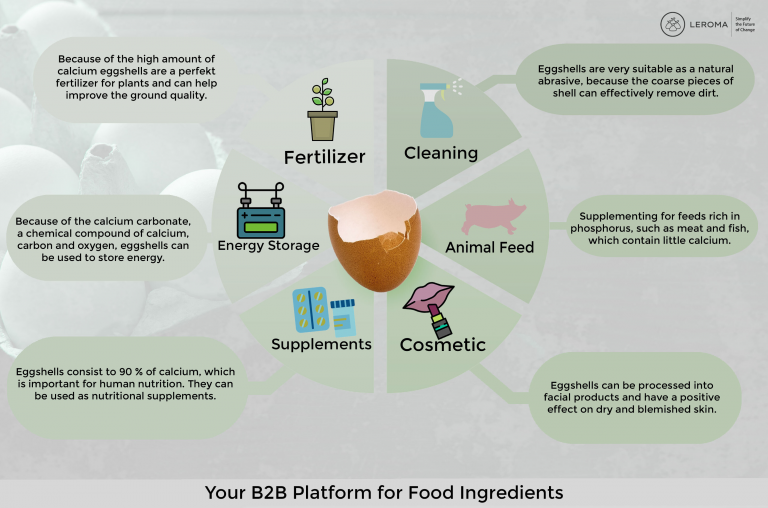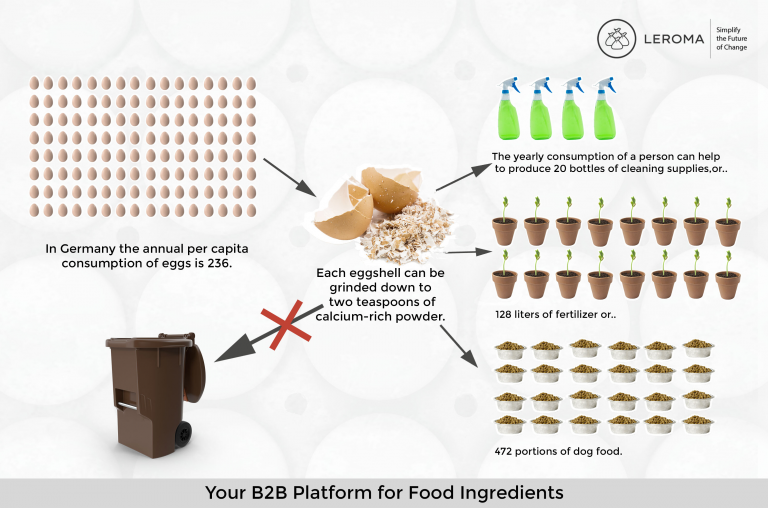Eggshells and their valuables minerals
Eggs come across us in various forms and it is hard to imagine the human diet without them, as we have already mentioned in our article about
vegan eggs. This time we deal with the classic animal variant, or at least with part of it. Eggs are not only cooked and processed into numerous egg dishes, but also used as a binder in dough and baked goods, as well as an emulsifier in egg liqueur and sauces such as mayonnaise. There are various bird eggs that are commonly consumed, such as quail eggs, ostrich eggs, goose eggs and duck eggs, but worldwide, chicken eggs are the most widely used for human consumption.
n 2019, the food consumption of chicken eggs in Germany was 19.6 billion pieces, which corresponds to a per capita consumption of about 236 eggs, and the trend is rising. With these numbers, we are still far below the front-runner Japan, where the per capita consumption is 320 eggs annually. What remains are the eggshells, which make up about 10% of the weight and end up in the garbage by tons, although they are way too good for that. In the following, we would like to show by means of various examples that eggshells are a valuable residual material that can be used in and outside the food industry.
Eggshells in the food industry
Eggshells consist of 90% calcium and contain other important minerals such as phosphorus and sulfur and essential trace elements such as copper, iron, manganese, zinc, fluorine and silicon. Calcium regulates muscle contractions, activates various enzymes and hormones, such as the clotting factor XIII (FXIII), which plays an important role in blood clotting, and is relevant for cell division as well as nerve functions. In addition, the mineral is a significant component of bones and teeth, to which it gives their hardness and stability. On average, the human body contains one kilo of calcium and over 90% of it is stored in our bones. In the case of calcium deficiency, calcium is released from the bones, which, among other things, can lead to osteoporosis and increase the risk of bone fractures and deformities, because the bones become more unstable and brittle.
Because of the high calcium content, eggshells ground into powder are excellent as a
dietary supplement for calcium deficiency. One teaspoon of eggshell powder contains up to 1,000 mg of calcium, which corresponds to the average daily requirement of an adult. Children aged ten to twelve need 1,100 mg of calcium per day and adolescents aged 13 to 18 need 1,200 mg. Eggshell powder can be mixed into drinks or sprinkled over meals, but it is only recommended for calcium deficiency, as a large increase in daily requirements can promote inflammation, cause kidney damage, or trigger cardiac arrhythmias, among other problems.
Eggshell powder can also be added to
animal feed, because animals need calcium just as humans do. It depends on the feed how much eggshell powder is added, because animals should not consume too much of it either. Supplementing the powder is especially good for feeds rich in phosphorus, such as meat and fish, which contain little calcium.
Even chickens can be fed with crushed eggshells. These would replace the shell lime or shells that are usually included in the feed as a source of calcium. Chickens have a particularly high calcium requirement, as they need the mineral not only to maintain bone stability, but also for egg production, as hens need about two grams of calcium per egg laid, which they must take in additionally through their feed. Calcium deficiency is manifested not only by brittle bones, but also by wind-laid eggs, eggs laid without a shell and surrounded only by a thin skin, or egg death, where the egg is stuck in the laying intestine, which can even lead to the death of the hens. When eggshells are fed to chickens, they should be extremely crushed so that the chicken does not take a liking to them and later pecks at its own eggs.
As a general rule, eggs should be washed with hot or boiling water or heated to 100 degrees to kill salmonella before being processed for human or animal consumption. There is also a patented mechanical
egg white recovery process in which eggshells are spun to separate, at least partially, the shells and the protein residue adhering to them. The egg white is collected in the centrifuge and the shell residues are ground into powder. Eggshell powder can also be added to
coffee in small quantities, as it filters the bitter substances and thus gives the coffee a milder taste.
Eggshells in the cosmetics industry
Eggshells can be used as a natural source of calcium in cosmetic products such as
face cream, because the mineral tightens facial skin and has a caring effect on dry and blemished skin. For this purpose, eggshell powder is mixed with egg white, for example. Eggshell powder can also be added to
nail polish to make a special polish that strengthens fingernails and is a natural alternative to conventional nail hardeners.
Eggshells in the cleaning industry
Eggshells can be crushed and processed into
scouring agents without chemical additives because the coarse pieces of shell scrub dirt from surfaces through friction. In addition, eggshells act as a
natural bleaching agent or brightener in detergents because they pull discoloration from white laundry. This property can also be applied in the form of toothpaste.
Toothpaste containing eggshell powder whitens and strengthens teeth.
Eggshells as fertilizer
Calcium is an essential mineral for plants, which loosens the soil and thus promotes the absorption of other nutrients. It also counteracts acidification of the soil and raises the pH value. Eggshells can enrich the soil with calcium when crushed, in powder form or processed into a liquid fertilizer. The rule is: the smaller the shells are, the faster they decompose and develop their effect. However, since eggshells provide almost only calcium, they are not suitable as a stand-alone fertilizer, but rather to supply calcium-poor soils such as peaty plant soil or particularly lime-loving plants with the mineral. Eggshells or calcium should not be distributed in conjunction with ammonium or phosphates because calcium forms unpleasant smelling ammonia when in contact with ammonium. Calcium and phosphate react to form sparingly soluble calcium phosphates, which plants can no longer absorb as a nutrient.
Egg shells as an energy store
Eggshells and the inner shell membrane are rich in calcium carbonate, a chemical compound of calcium, carbon and oxygen, which can store energy. Attempts have already been made to use eggshell powder, made from boiled, baked shells supplemented with a binder, as a power storage device. In tests, electrodes made from the powder were able to maintain a capacity of 92% over 1,000 charge and discharge cycles. Further research could therefore produce low-cost and sustainable batteries from eggshells in the future, which might then even make a significant contribution to global energy storage.
Other applications
Eggshell powder can be used to make inexpensive
crayons, for example by mixing the powder with flour and water to form a thick paste, which is then colored with food coloring and subsequently dried in the desired form.
In addition to the outer lime shell, the eggshell also includes the inner, thin shell membrane, which can be used not only as a component of eggshell powder but also separately from the shell.
Eggshell membrane
Eggshell membrane is rich in proteins and glycosaminoglycans, which have a positive effect on human cartilage tissue. Glucosamine, which stimulates the production of synovial fluid and binds water in cartilage tissue, supports joint gliding, i.e. it influences cartilage degradation and promotes tissue regeneration. Eggshell membrane is processed into
food supplements in the form of powder and capsules, which are supposed to help especially in
ostheoarthritis.
Osteoarthritis is the most common joint disease worldwide, affecting about five million Germans. Because cartilage is continuously being broken down and the cartilage tissue destroyed, the bones rub against each other without protection, which leads to pain for sufferers. The glucosamine in eggshell membranes slows down the degradation of cartilage and can thus slow down the progress of the disease and reduce the signs of wear and the resulting pain.
As we can see, eggshells are already being used in numerous industries and are obviously at least as valuable as the egg we have known and loved for many years. We at LEROMA hope that more companies will become aware of the benefits of eggshells, so that they can pass on the valuable waste material or put it to a new use themselves. Of course, you can also advertise
eggshells on LEROMA`s platform to find potential buyers and reduce waste at the beginning of the value chain.
Let's simplify the future of change!





